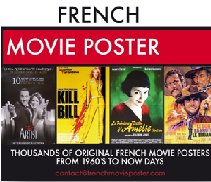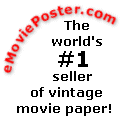The companies that actually handled
the making of the plates that the printer used to print the posters
were known as lithographers. For each size of poster in a movie's
ad campaign, the movie studio art departments would ship the original
artwork to the lithographers. These were known as "reflective"
or "hard" art, which meant the original piece of artwork, and
a "mechanical" art, which showed the positioning of titles and
credit information.
How the Plates Were Made
The early lithographers used huge
limestone slabs, known as Stone Lithography.
Later, zinc was used for the plates until the offset press became
the primary printing method.
Movie companies were very strict about
the size and placement of stars' names in relation to the film's title.
The lithographers were not allowed to make any changes without checking
with the movie studios first.
When the lithographers finished
making the plates, they were either sent to printers OR sometimes
the lithographer also had the ability to do the printing as well.
They were then sent to studio exchanges, independent poster exchanges,
or later National Screen Service.
Larger sized posters, such as
three sheets, six
sheets, and twenty four sheets were
sent directly to the "posting companies" who placed them on billboards.
Keeping Track of the Plates
Early posters were handled a lot different
before National Screen Service took control.
Before NSS, the majority of lithographers also
did the printing, so quite often plates numbers (their reference
numbers) weren't put on the posters because it was all handled
in-house. Each lithographer had their own method of keeping track
of the plates. It was very common for the studio to need more
posters for a campaign and ask for more to be printed, so the
lithographer would have to keep a master plate.
For larger lithographers, they would put a
litho number on the plate so they could easily find the plate
at a later date. It was very common for studios to need more of
a certain poster. The litho numbers were a type of reference of
filing number that helped them locate the correct plate.
These plate numbers can be very important in
helping us date certain posters.
History
A number of lithography houses lent
their expertise and talent to the development and growth of the movie
poster in all of its sizes and forms. Some of the lithographers that
helped with development were: Donaldson Print Company who printed the
American Entertainment Company stock poster of 1900, Miner
Litho Company who did printing jobs for United Artists. Hennegan
Show Print in Cincinnati was the lithography house used by Thomas
Edison for his first programs. Hennegan also printed posters for some
films released by Triangle
Studios. Triangle Studios also utilized the services of United
States Printing and Lithograph Company, another New York company,
for some of its posters. Edison later contracted with A. B. See Lithograph
of Cleveland to handle the Motion Picture Patent Company's printing.
Other lithographers who contributed
to movie poster printing included Greenwich
Litho who produced posters for Mutual,
the distributor of films for Komic, American Film Manufacturing Company,
Majestic and
Thanhouser. Acme
Litho of New York handled the advertising for Pathe
Studios, while another New York lithographer, J.
H. Tooker, printed the posters for Vitagraph.
Richey Litho
Company, Otis
Lithographic Company out of Cleveland, Ohio and H. C. Miner Company
out of New York were 3 other major lithography companies.
By the 1930's, the big three were
considered Joseph
H. Tooker Litho Company of New York, Continental
Litho Company and Morgan
Litho Company.
Many posters will carry a tag
line which gives the name of the lithographer. Newer materials,
however, do not contain the name, but note that it is a "U.S.
Litho."
For information such as history, logos, and plate numbers on individual lithographers, go to our Lithographers/Printers Log





